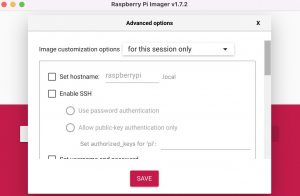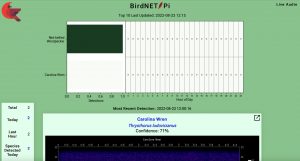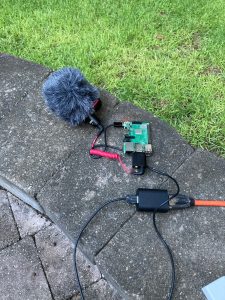I’ve been on a Raspberry Pi project tear lately. Somehow or another I stumbled into BirdNet-Pi and the best way I can describe it, is that it is like Shazam for bird songs. It records the call and frequency and plots it on a spectrograph and identifies the bird.
Very Cool!
About a year ago I married my long time girlfriend and we bought a new home just outside of town. We are on a 1 1/2 acre heavily wooded plot that also has a creek running along one edge. So the birds love it here. And my wife loves birds and keeps the feeders clean and full. So I really did this for her but this project has got me super excited about all the different species of birds around here and their distinct calls.
It’s easy as heck to build. You need:
- Raspberry Pi – latest is best however I built this with an older Pi 3 B+. It runs fine on there.
- SD card to install Pi OS. BirdNet-Pi says to use Pi OS 64 bit Lite.
- USB microphone. Initially I used an $8 USB mic and it works but the better the mic…….the better the results you’ll get. I used a Rode mic that costs about $50.
- OPTIONAL – if you use the better microphone you will need a USB Sound Card. to plug the mic into. The better mic and sound card make the project a bit more expensive but I think you’ll be glad that you went that route. if you just want to dabble then just use the cheap mic.
NOTE ON MICROPHONE: Because the Rode mic I linked above costs $50 and it is a directional microphone I did some research and found an omni-directional mic that costs $20 less. It is a Lavalier Clip On mic. I’ve had it up several hours and my bird call detection is WAY up.
That’s it. Install Pi Os 64 bit Lite with Raspberry Pi Imager. Be sure to hit Command +Shift + X (Mac) (probably Control + Shift + X on windows) before you write the SD card. This allows you to set up wifi and change the hostname and change the timezone and set up SSH if you want.

Pi Imager
Lets proceed!
Now you either need to ssh into your Pi or have a monitor, keyboard, and mouse installed.
Before you start make sure your pi is up to date.
sudo apt-get update && sudo apt-get upgrade -y
Once that is done reboot your pi. To install BirdNet-Pi is a piece of cake. Just run one command in the terminal.
curl -s https://raw.githubusercontent.com/mcguirepr89/BirdNET-Pi/main/newinstaller.sh | bash
This will take a bit. Maybe 15 minutes. Once it is complete navigate into a browser and go to:
http://birdnetpi.local
It will open a page that looks like this.

Now set that sucker outside and let it start doing its thing.

I won’t get into the nuts and bolts of it too much but once you detect a bird it allows you to click on a link to see a pic of the bird (on a wiki page), not your actual bird. It also records the calls and you can play back those recordings in the browser but one thing I did notice that is there is no way to download the mp3 file from the browser.
What you need to do is get an SFTP client like Cyberduck or FileZilla and then you can SFTP into your pi and download the MP3. This is really the only weak point I see in the program.
Anyway, I need to find a way to make this weatherproof yet still have the mic exposed. This could be tricky. For now I’ll just set the Pi outside.
In just over 24 hours I have detected 18 species of birds and over 620 bird calls. Amazing. Simply amazing.
As far as Pi projects go, this is EASY. Install the OS, Install BirdNet-Pi, and set it outside in range of your wifi (or ethernet).
I find this project extremely engaging and interesting and I’ve never been a Nature Boy………..WHOOOOOOOO.
UPDATE. Stardate 2 weeks later
I’ve had this up a couple of weeks now and I am stunned and amazed at how wonderful this is. I built this for my wife but it has been a great experience for me as well. In two weeks we have had over 40 species of birds detected and I’m beginning to learn to detect some species visually and audibly. I’ve also began to photograph the little flying devils as well when they come to get a snack at the bird feeder.
I’ve had a couple of issues.
- I’ve yet to find a power brick that will run on 120volts that doesn’t inject tons of hum into the microphone. As it is I’m powering it with a Jackery Portable Power Station. Regulated DC from a battery.
- This is a tough mother to waterproof and in fact a sudden shower popped up the other day and blew up my Raspberry Pi. Fortunately it was an old Pi and even more fortunately it only popped the polyfuse (self resetting thermal fuse). Still if it would have fouled up a Jackery, a Pi, a USB Sound Card, and a microphone I’d have been pissed. I have to be very aware of the weather and sometimes I’m scared to leave it out at night which stinks because that’s when the owls come out to play.
- Along those lines I was setting my rig up at 5 AM and heard a Barred Owl just as loud as can be. I came in and told my wife “darn it, I missed catching the Barred Owl” to which she smartly replied, “BUT YOU HEARD IT WITH YOUR OWN EARS”. Yep. She was right. Again.
- There is no way to delete a false detection, and while there aren’t many…….there are some. BirdNet thinks the dogs barking across the creek are Eastern Screech Owls.
Still, this is right up there in Pi projects. You can’t go wrong.

John – really appreciated your post on this. This was my inspiration for getting my system set up. The only trouble I’ve found is with the lavalier mic. My Pi isn’t picking up anything depiste lsusb/arecord -l show that it is connected and working.
Did you do anything to configure the lavalier mic? And did you plug it directly into the 1/8″ jack on the Pi or to the Sabrent external audio card? I think I got confused with your “Optional” comment regarding the sound card and what “better” or “cheap” mic really meant.
Thanks again!
You have to use that adapter that comes with the mic. It stumped me for a bit too! it plugs into the external sound card
So do you mean like this: RPi < Sabrent Adaptor (pink slot) < Extra Cord from Mic < Mic?
I thought that adaptor that came with the mic was just an extension cord!
That seems wild! But I will have to give it a try…
Great write-up. I am about 5 days into my BirdNet project. I thought it was interesting your Eastern Screech Owl findings. Mine picks up the fire department sirens about a half mile away as Eastern Screech Owls. I’m in the city. Probably not a lot of those around here.
I use a Samson Sagomic in the windowsill and carefully close the window on the cord. I will put some felt insulation to decrease the pressure on the cord and keep out the cold. I left it out all winter in Minnesota. I now have 280,000 recordings over the past year and 165 species. You can tell what birds are migrating by what the main recordings each day. I have a 512 megabyte micro sd card and it still has 120 megabytes until full. I plan on transferring the recording to an external 1 terabyte external NVME for the next year. If the power goes out or my wife unplugs it when cleaning, it reboots automatically. I just use the standard Pi power wart and have had no problems with hum.